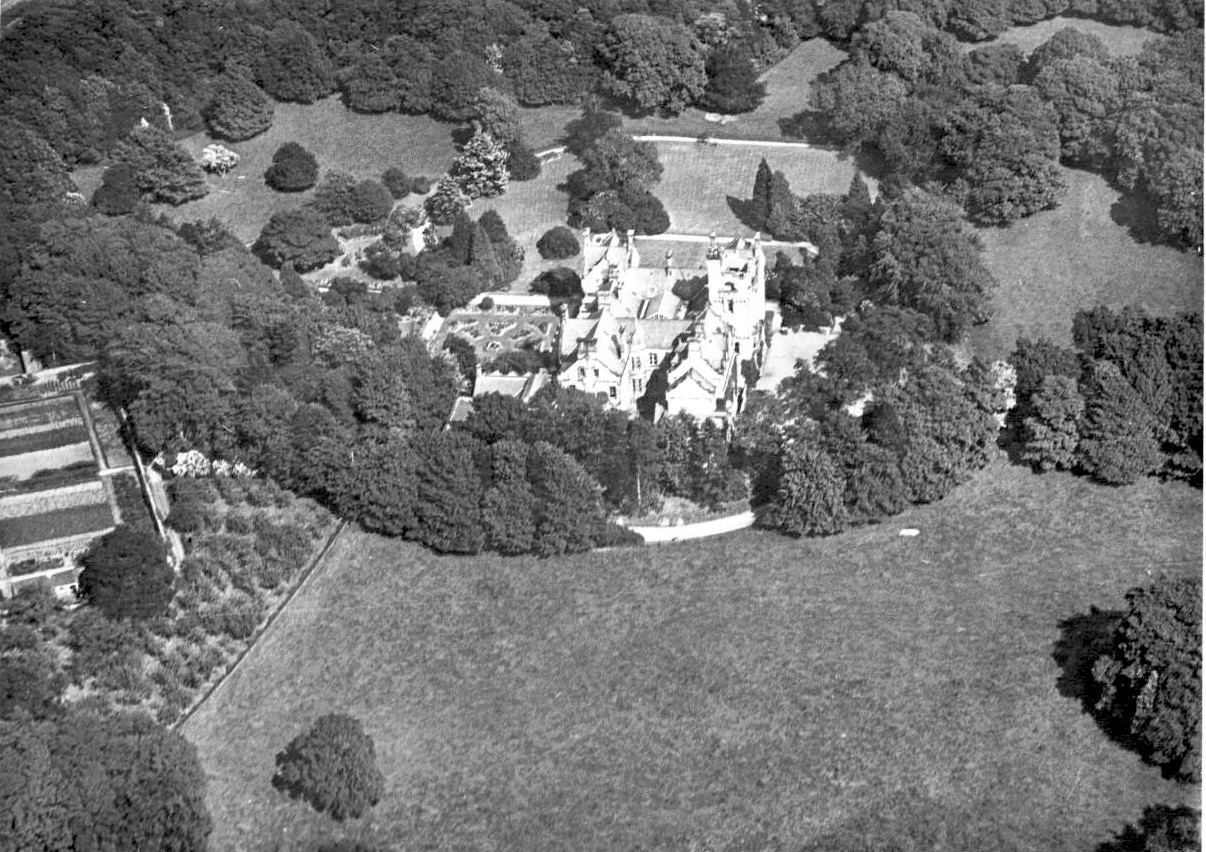| Under construction | Wilfred Burton Rowley Kennedy | Norwegian version |
In the mid 1880'ies a young Englishman by the name of Wilfred Burton Rowley Kennedy arrived at small community by the Sognefjord in Norway. At this location, called Sogndal, he entered as a guest at the hotel "Danielsen". He soon got a reputation of being a clever hunter and angler. Most commonly known is the fact that he on the 25th September 1886 signed a contract with one Jens Undahl to rent an old match factory in the valley for 15 years, he should not make matches and all existing machinery should be removed. At several occasions earlier this factory had burnt down. The fire at 3 October 1884 was very serious, no further production was possible. Up to 110 women and men had their daily work there, in addition there were much unemployment in the valley. Wilfred was offered to purchase the factory for a sum of kr 20,000. It was bought by him at the 13th May 1887, already he had made it into a textile factory with 13 loomes. The parish was now welcomed with new industry giving employment to a number of persons and a marked for the local production of wool from a number of small farms along the fjord. But already the next year he sold the factory to the local sheriff Nils Lem. Also at this time he bought an old estate "Bahus" for an amount of kr 12,000 and gave it the new name "Ulverston".
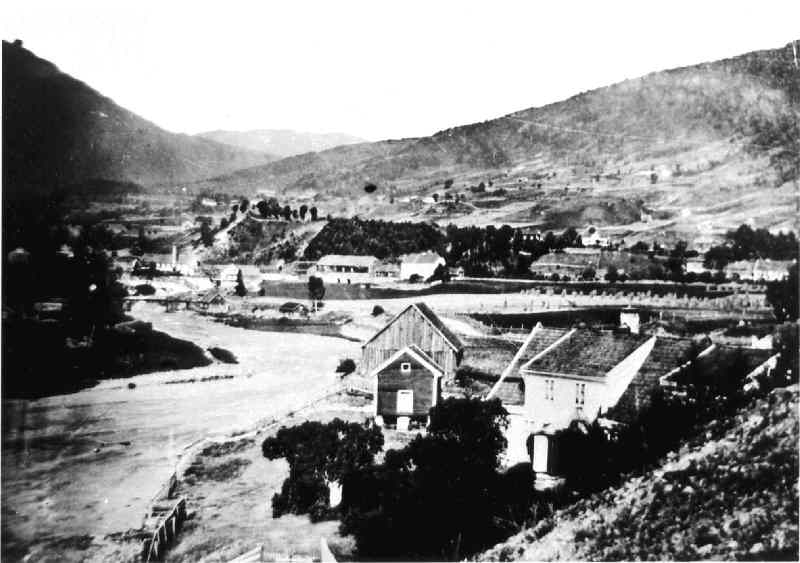 Ulverston at the time of Kennedy. The textile factory is seen with a high chimney behind the waterfall at left. |
It was probably Kennedy who installed a
large open stove of the finest British make in the large
drawing-room. My Grandfather arrived as a new resident in the
autumn of 1922. When he decorated this room and removed old
wallpaper several small bullet holes could be seen in the
timbered wall to the east. It appeared that Wilfred had been
exercising pistol shooting with his friends as the tradition
told. At Årøy (Aareoy), an area at the end of the Sogndal
fjord, a well known salmon and trout river with several water
falls can be found. Wilfred was famous for catching in 1894 a
salmon of 63 lbs, one of the largest to be seen in this part of
Norway. In previous times a cabin to host visiting anglers was
located by the river.
It is told that Wilfred had a cabin of his own there and that he
prepared parties for his servants which included two maids as
well as two hired men.
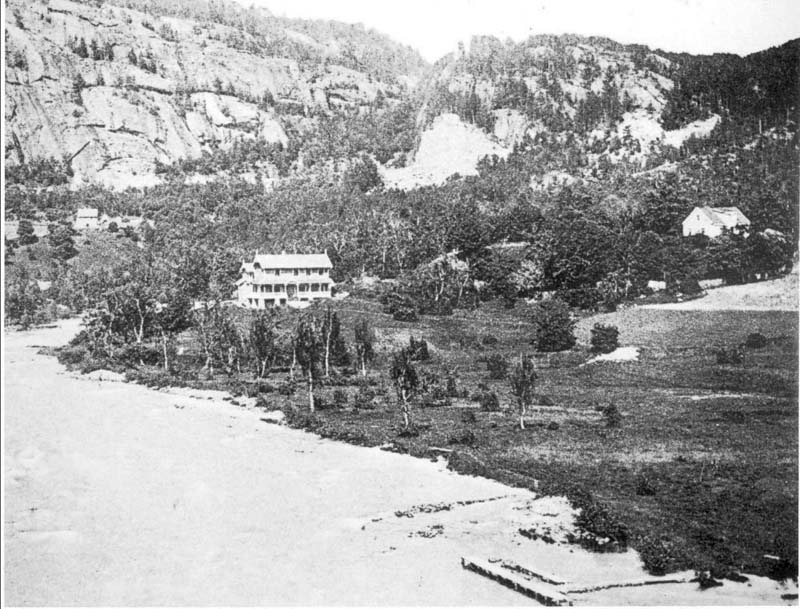 The Årøy River with the "English House" |
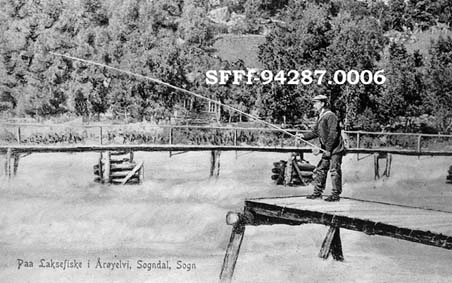 Fishing in Årøy River (old post card) |
On the front wall of the anglers's cabin drawings of the largest catches were made. The cabin is long gone. But a photo of this wall exist on which we can see Wilfred's salmon. A nearby mansion ("The English House") where the visiting anglers stayed has also been demolished and burned (1966).
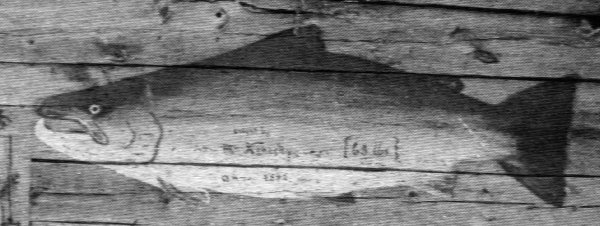 Drawing of Kennedy's salmon on the wall of an old cabin by the Årøy River. |
According to church records Wilfred died on the 18th August 1894. A doctor was called and the cause of death recorded as heart failure. He was buried on the 25th August at the Stedje church yard only 31 years of age. His occupation was recorded as "Landlord" and "Gentleman" and his place of birth Ulverston, England. Old tradition tells that he hang himself in a certain room at the attic of his house.
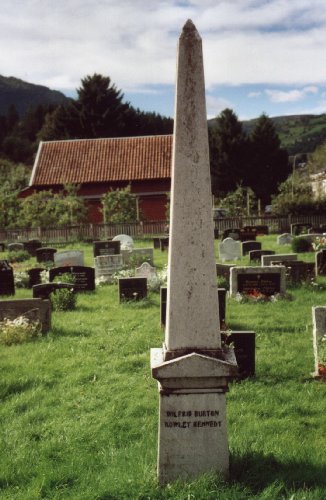 Wilfred Kennedy's grave. (KLG, 2001) Has been removed. |
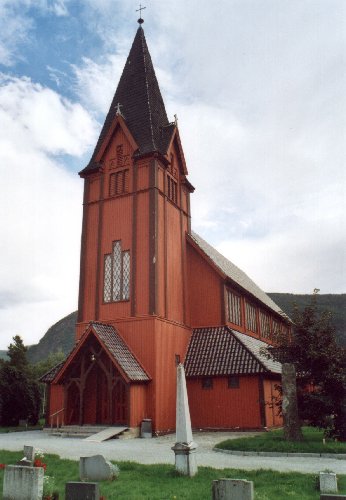 His tombstone in front of Stedje Church. (KLG, 2001) |
Who was this English Gentleman?
In the census of 1 January 1891 he is listed as the main person
and "Gentleman" at Ulverston. The person doing the
census has also written down his occupation as
"rentier". It is listed that he was married to Emielie
Augusta Kennedy, born 1868 in Bremen (probably Germany).
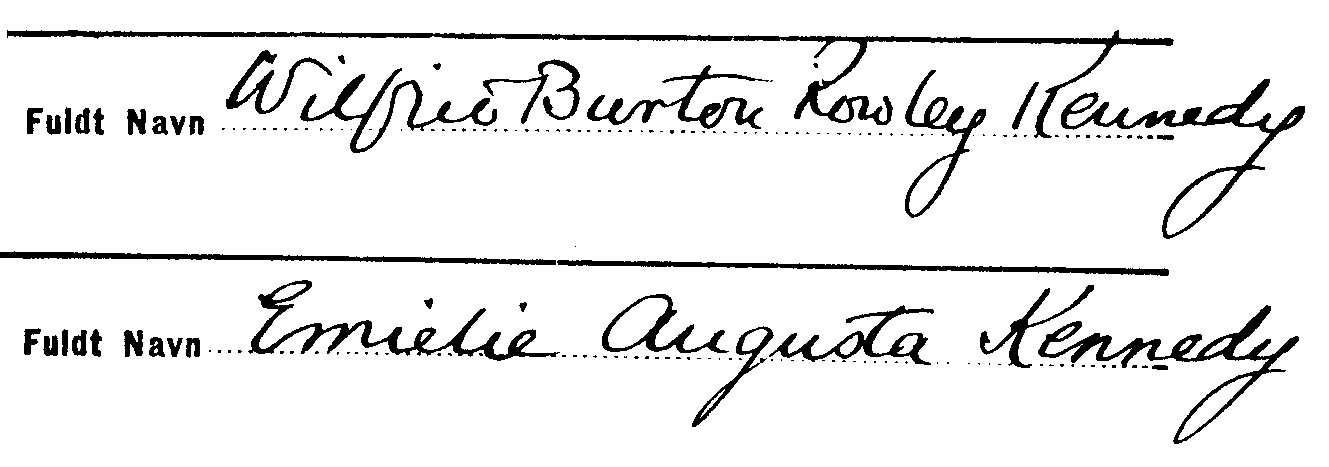 |
 Wilfred's clock in Norway given to one of his housekeepers. Photo: Atle Bondvik, 2006 |
In the list of dwellers in the house we also find Sigri Pedersdaughter, "Servant, Kitchen maid", born 1844, locally, as well as Andria Rosendahl, "Housekeeper", born 1848, Kvalvaag, Salten, North Norway.
Wilfred and his wife got one child,
Myles Cassilis, who was born in Bergen 10 September 1893. Tuesday
on the 19th October 1893 he was christened in Stedje church in
Sogndal. The parents were listed as Wilfred Kennedy, b. 1863,
Ulverston, England, and Emilie Augusta Stengler, b. 1868, Bremen. (In
a Kennedy genealogy Report she is listed as:
"Emilie Augusta Glauert only dau. of Roland Glauert Bergen, of Norway").
The Godparents were listed to be no less than: "Sheriff Lem,
Landowner (Squire) Nils Knagenhjelm and his wife Mrs Augusta
Knagenhjelm, Mrs Magda Knagenhjelm, Myles Kennedy" (Myles probably not present since at bottom of
list).
Sheriff Nils Landmark Lem and Nils Knagenhjelm were active leaders of
the local bank and did much good for the community. It was of
course also important with new rich investors. A Great-Grandchild
of Lem tells me that his grandfather told him of his father's
friendship with Kennedy.
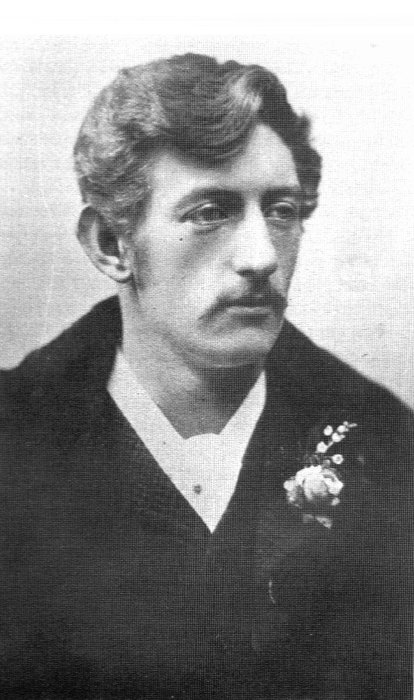 Wilfred Burton Rowley Kennedy |
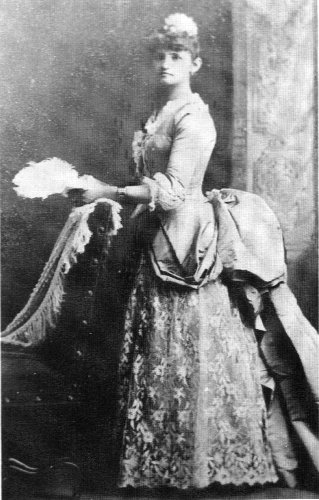 Emielie Augusta Kennedy |
Local tradition tells that Wilfred had been in Africa, probably because he suffered from asthma. He married a lady who had been a circus dancer or something of the sort. His family did not approve and it was believed that he might have been an outcast expelled to Norway. Having got a son he decided to stop taking morphine. Probably it was administered so hasty that he was taken ill and died. His family arrived and the widow was offered to stay with them if they could take care of the upbringing of the boy. The housekeeper, Marta Vangestad, travelled with them back to England. After a while she returned as she did not feel comfortable in a large foreign house. Soon after WW1 his son, now an officer, visited his fathers grave in Sogndal.
Wilfred did not prosper by his stay in
Norway, and probably did not lead a healthy life, being addicted
to morphine. His son Myles Cassilis got a good education, at
Malvern, and the Royal Military College, and was a Captain of the
Late 13th Husar. On 15 Nov 1917 he married Beryl Maud, 3rd.
daughter of R. H. Gosling, of Hawthorn Hill, Berks. and got two
daughters. In 1931 he married Mollie Mildred Pady, in this
marriage he also got two daughters. Myles Cassilis died 3 Jan
1947.
Wilfred had an older brother by the name of Myles, a
Great-Great-Grandchild of him living in Ulverston has provided information about Wilfred's family.
The textile factory burned down in 1898 and was rebuild with larger premises at the same location by the waterfall at a place called Foss. In my time it was a comparatively large factory with up to about 60 workers. After the death of Kennedy "Ulverston" got back the old name "Bahus". Now it was bought by Dr. Ole Benjamin Schøyen from Vinger in Norway for kr 6,000. He had a great interest in gardening and made a magnificent garden.
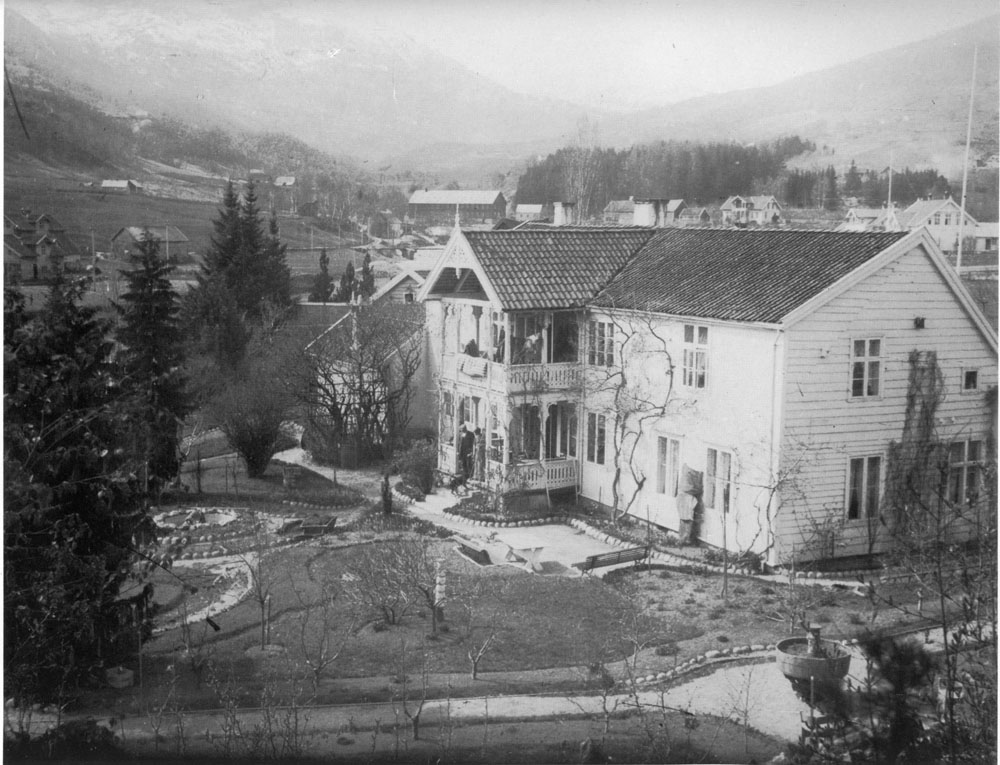 Bahus in 1915 after Wilfred had left (uknown photographer). Demolished in 1962 to make room for a modern hotel. |
After Dr. Schøyen had died in 1921 the place was bought by the municipality for kr 60,000 to be used as a resident for doctors. My Grandfather moved in on his 50th birthday in 1922. In December 1961, at an age of 89 år, he moved to the Oslo area. The house and the garden was now levelled with the ground to make room for a new hotel. The magnificent garden is gone, only few of the beautiful trees remain.
Some info on Wilfred's family background
Wilfred Burton Rowley Kennedy was one of fifteen children of Myles Kennedy and Margaret Rowley, in Ulverston, Cumbria. Myles was the owner of several iron mines in the area and lived in a large stone mansion and a tower with a panoramic view of Morecambe Bay and the Lake Mountains. The building was called "Stone Cross" from an ancient stone cross which stood near the site. Wilfred was born on the 8th July 1863 and was educated at Cheltenham and Trinity College, Cambridge. He served as a lieutenant with a local military Regiment, the 4th Battalion, Royal Lancaster Regiment.
The Lonsdale House in Ulverston was the
home of a Myles Burton, whose daughter Elizabeth was born there
in 1800. In 1817 he buildt a house Fair View near the centre of
Ulverston. In 1819, Edward Kennedy came to Britain from New York
and his son Charles fell in love with Elizabeth Burton. The
couple wanted to marry, but she was under age and her father
refused to give consent.
Deciding to elope, it was told, they set off in a coach, but
Myles Burton returned home and found his daughter missing and set
off in pursuit in such a hurry, the story goes, that the coachman
had not enough time to get properly dressed. But the eloping
couple met with one misfortune after another, first one of the
horses lost a shoe and then the wheel came off the carriage, that
they only got as far as Newby Bridge, when a somewhat angry
father caught up with them.
Elizabeth was brought back to Fair View and for a year and a day,
was constantly accompanied round Ulverston by a maid, to make
certain that she did not attempt to elope again.
In the end Myles Burton resented and allowed Charles and Elizabeth to marry. Charles set up as a doctor in Broughton, but
in 1821, when Myles Burton died, Elizabeth inherited the house
and property and the couple moved to Fair View. In 1835 they got
a son called Myles Kennedy.
Charles's father Edward had a brother who had attended Cambridge
to read geology. In the 1840's he started mining at Askam in the
hope of finding silver, but instead he found iron ore. The
Kennedys took out a lease on the land from a Col. Mckinnen of the
Lotts, Askam, for two years, but when the period expired he would
not grant an extension.
Fortunately, though, for the Kennedys, the iron ore field ran
into the adjoining property, although the owner was unaware at
the time that iron ore existed on his land. The story goes, that
at that time, Squire Sandys had a town house in Daltongate, the
house that is now the Bible Shop. One day he met a member of the
Kennedy family in Daltongate and told him that he had just bought
some property at Roanhead, as a place to keep his greyhounds who
were making too much noise, and offered the lease on the
adjoining land, where the iron ore had been found by the
Kennedys. "From that time neither the Kennedys or the Sandys
looked back", it is told.
Tremendous wealth came out of the iron ore mines between 1851 and
1923, but their hey day was during the Franco-Prussian war from
1870 to 1873. The mines were named after members of the family:
Nigel, Kathleen, Violet, etc..
Although Fair View in recent years was the established home of
the Kennedys, originally their house were at Hill Foot and Stone
Cross. It was Myles who built Stone Cross after making an
unsuccessful bid for Conishead Priory. Col. Bradyll wanted
£35,000, but Myles would offer no more than £30,000. Both were
stubborn men and neither would give in. In the end Myles decided
to build Stone Cross and had spent more than £35,000 before the
first floor was completed. The main building, built of white
limestone with Hexam freestone dressing, was established in 1874.
The final bill, when it was presented in 1880, was a colossal £44,872 - 2s. - 2d.
(Ref.: Newspaper "THE NEWS" interview
with Col. Hugh Kennedy, Fair View, April 18, 1966)
Myles Kennedy married Margaret Rowley (born 1834) on the 24th October 1860. Among the 15 children (6 sons and 9 daughters) the two oldest were: Myles T. Burton (born 1862) and Wilfred Burton Rowley (born 1863).
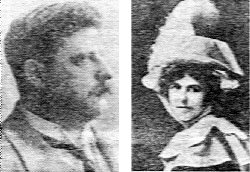 Mr. and Mrs.Myles Kennedy |
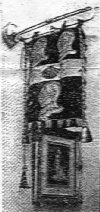 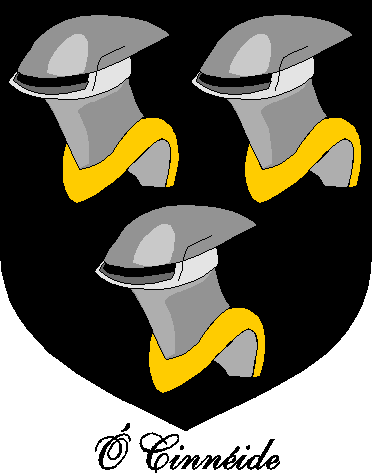 The Kennedy coat of arms |
Wilfred's home - Stone Cross in Ulverston Pictures of the old mansion |
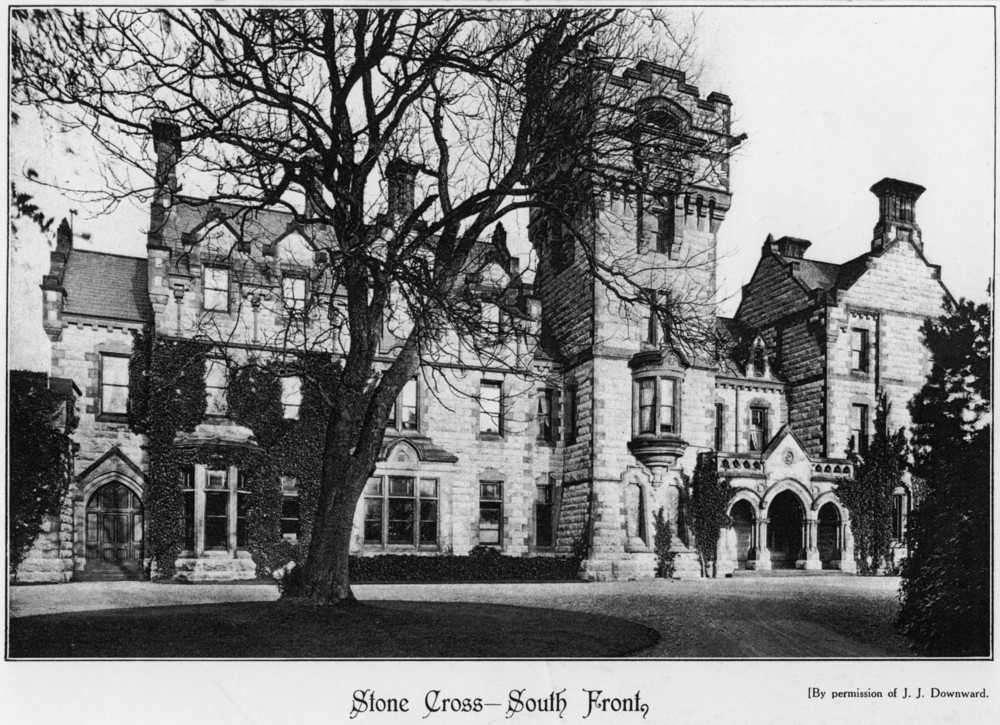 A Gothic-style white limestone mansion buildt for the Kennedy family in 1874. Designed by J. W. Grundy. |
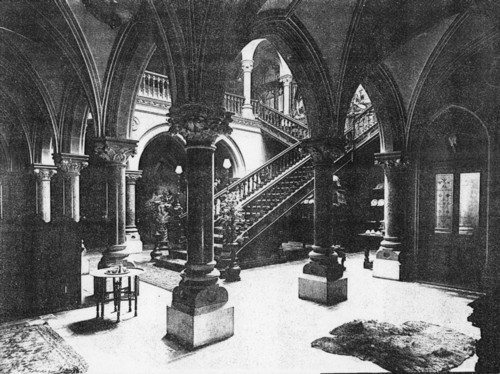 Main hall with magnificent oak staircase which was removed and burnt. |
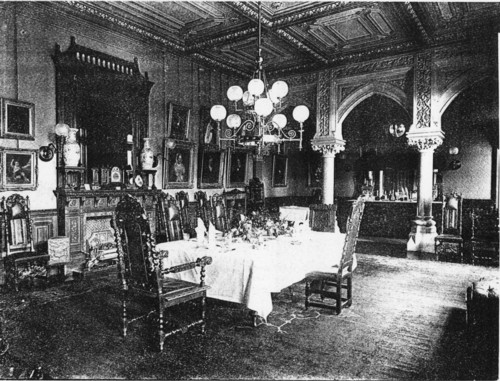 The dining room |
More photographs of Stone Cross Manor
These photos belong to Brian Ainley, former owner of Marl International.
Correspondence by Mike Hancox.
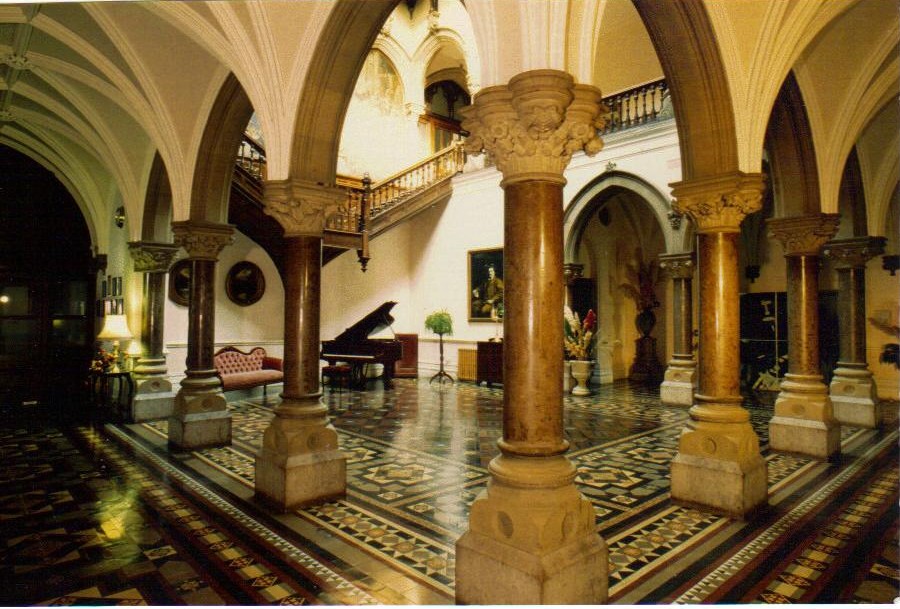 |
 |

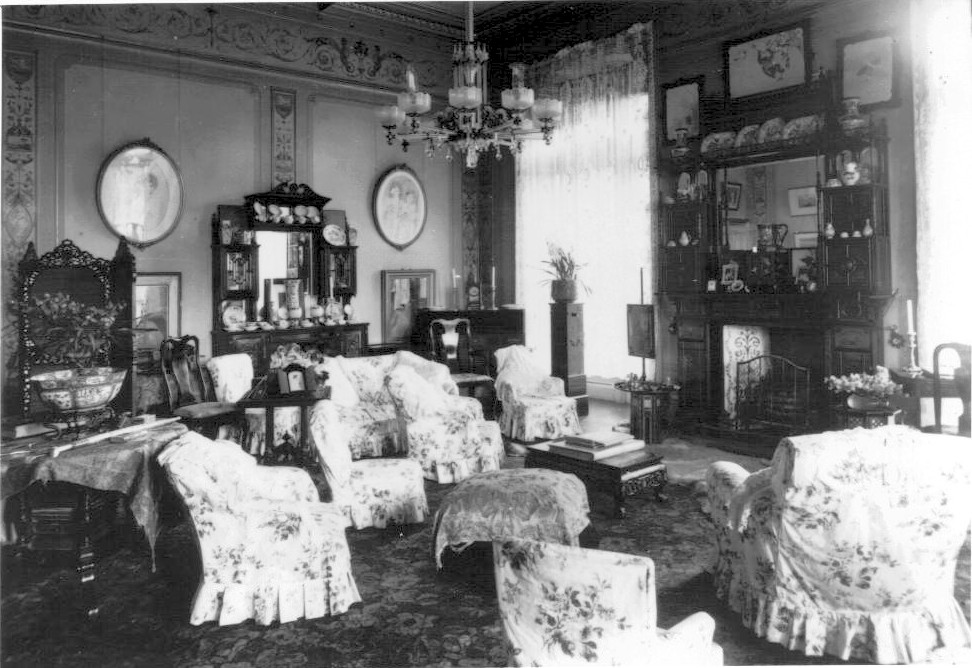
|
The Kennedy family was living at Stone
Cross to about 1950. The mansions more recently use has been as a
special school owned by Lancashire County Council. In the main
hall a beautiful oak staircase was demolished in order to
facilitate the playing of indoor football. In the early 1980's the
mansion and the estate had been acquired by a group of London
businessmen. They wanted to make a 50 room "first class" hotel. In
recent years (1986 - 2002) Stone Cross Mansion was the head office of local company Marl
International. Marl spent hundreds of thousands of pounds on the building,
slowly restoring it and also bringing historic items back to the house.
In 2004 the building was put to fire and decimated by vandals. At the present
moment there is a big dispute about its ownership and also if when sold
what Its Future Use Will Be.
Information from Carol Bennett at the "Ulverston Heritage Centre"
More of the Kennedy clan: http://www.kennedysociety.org/clan_info.htm
Thanks to Ken Barltrop , Clive Park, Myles Kennedy, Mike Hancox, and others, for information
New Web Page about the Stone Cross School and its Old Boys.
Ulverston, a town in Cumbria south of "Lake district".
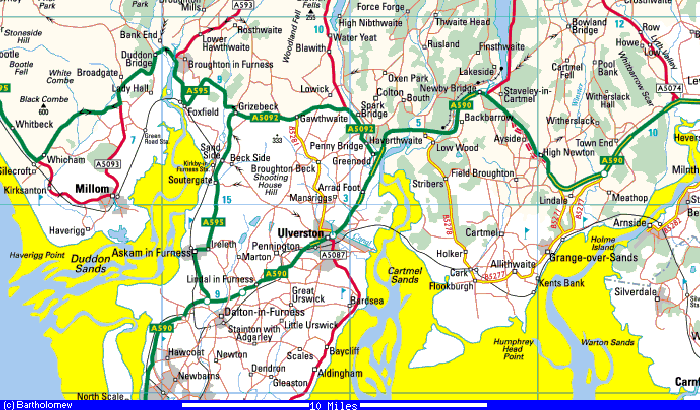
Information can be found
at: http://www.liv.ac.uk/~mhbarker/ulverston.html
Any comments? Please reply to: kgroenha(at)online.no (Substitute (at) with @ )
